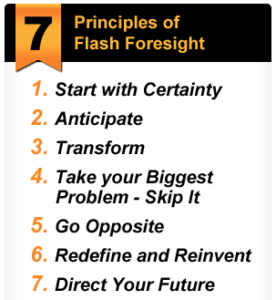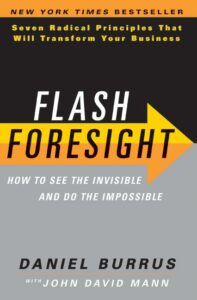Daniel Burrus is a world renowned business strategist, futurist and technology forecaster. He is the CEO and founder of Burrus Research, a firm that helps spot trends for clients to take advantage of coming market forces. His latest book Flash Foresight is a New York Times and Wall Street Journal bestseller.
In his book, he outlines seven principles of transformation including:
1. Start with certainty
2. Anticipate
3. Transform
4. Take your biggest problem—and skip it
5. Go opposite
6. Redefine and reinvent
7. Direct your future
You provide seven triggers for users to pursue to create their own flash foresights. What’s the history of the development of these triggers? Which came first? Did you end up discarding or merging other potential triggers?
Over the years I have founded and managed six companies, four were national leaders in the first year and five were profitable in the first year. Before starting Burrus Research 29 years ago, I used all of the triggers except one, Start with Certainty. In starting my first four companies, I had not formally identified any of the triggers yet. Because I taught biology and physics before starting any companies, and had never taken a business course, I knew I had to be more creative and focus on innovation in order to be successful.
After founding my research company and developing the concept of identifying Hard Trends, trends that will happen, versus Soft Trends, trends that might happen, I began using Certainty in a formal way.
Over the years I have been speaking, consulting and writing about new breakthrough technologies and game-changing strategies. From that work, I have developed a fairly large list of great strategies.
My consulting clients, mostly all Fortune 500 companies, have said that I help them to see invisible opportunities and solve seemingly impossible problems. (Now you know where the subtitle of the book came from). So I asked myself, can only I do this, or is there a process I use that I could teach to others?
After reviewing all of my work and how I have been able to quickly come up with game-changing strategies that can monetize quickly, I realized that I use the seven triggers every time. That is when the idea for Flash Foresight was born.
In addition to the seven triggers of flash foresight, you guide users through eight pathways of technological advancement and three digital accelerators. As with the story behind the seven triggers, can you share some background of your development of the eight pathways and three accelerators?
In 1983, when I founded Burrus Research after conducting an intensive year of research, I identified the three digital accelerators. The first was easy; I knew about Moore’s Law and believed it to be valid and a great way to see what future computing capabilities would be like at any given time and into the future. Because of the extent of my research, I was able to identify the other two digital accelerators, storage and processing power. A mistake I made at the time was not putting my name on them, but I did use all of them, along with a Taxonomy of High Technology. I also identified at the time the 20 technologies that would shape the future to base hundreds of predictions that have proven over time to be accurate technology predictions.
In 1985, I identified the eight pathways: networking, dematerialization, virtualization, product intelligence, interactivity, mobility, globalization, and convergence. At that time, I stated that they would all increase in proportion to the three digital accelerators, and they have. I have been sharing the pathways in my speaking, writing and consulting ever since I published them in ’85.
Of the seven triggers, which one seems to be the hardest for your clients to grasp and accomplish? Why?
Redefine and Reinvent. I think the reason is simply that business process innovation, as well as product and service innovation, takes time away from doing what we think our job is, managing the day-to-day operations of our businesses, putting out fires and crisis managing. When times are good and when times are bad, everyone is way too busy to redefine and reinvent. However, the ones that take the time to redefine and reinvent, such as Apple and many other large and small businesses I mention in my book, are profiting greatly.
What’s the difference between change and transformation?
When I was a young boy, I would listen to my music, one album per spinning disc that was a large 33 1/3 LP. As I got older, a technological “change” came along that let me listen to one album per smaller spinning disc called a CD. Now I have all my music, videos, photos, emails and access to the World Wide Web on my phone. That didn’t change how I listened to music, it transformed it.
One of the triggers is “Go Opposite,” which I appreciate. Contrarian thinking often provides opportunity. There are times, though, that the crowd shows surprising wisdom. When is it right to go with the crowd and when should you go opposite?
It is always better to go against the crowd. Crowds seldom show wisdom, they usually can only muster good and sometimes actionable knowledge. Also, the conclusions of the crowd are present focused and will not help you see things in new ways. I think crowd-sourcing creates a good data point but not a great end point. Going Opposite creates better insights and endpoints.
What’s the key to staying on track with flash foresight thinking? In other words, how do you help clients counter the pressure to go back to reacting to the daily fires and urgencies?
To create an urgency-based discipline by looking into what I call the visible future on a monthly basis and create an internal Tomorrow Lab that is not distracted by the present and is focused on the future.
Technological change is clearly the largest driver of flash foresights. Are there other areas in the physical sciences or social sciences that we should also mine for insight?
Demographic changes create predictable Hard Trends that let you see and act on amazing opportunities. Government regulations also create Hard Trends that represent opportunities to innovate if you look at them in the correct way.
You end your book with a call to action: for each of us to set up a “tomorrow lab” to structure and implement our flash foresight plans. What should come next? How should we weave our individual thinking into a collaborative endeavor?
This is a unique time in human history. In the next five years we will see a major transformation in how we sell, market, communicate, collaborate, educate, train, and innovate. This represents amazing opportunity to create new products, services, markets and careers. It is the biggest Game Changer to ever happen, but most are too busy managing today’s problems and looking at the future with present thinking. Last year, over 70% of Apple’s revenue came from products that were impossible just a few years ago. Last year, over 40% of IBM’s revenue came from products and services that were impossible to do two short years ago. The three accelerators are going vertical, driving unprecedented transformation. This has urgency written all over it. The key is to recognize this and work together to create a better tomorrow now!
Remember: If it can be done, it will be done, and if you don’t do it, someone else will!
You’ve given us Technotrends and now Flash Foresight. So what ideas and thoughts do you have for further development of these lessons and insights?
I cannot give you all of the details now, but I can say it is around the predictable, game-changing transformations that are taking place globally and how to take advantage of them now.




